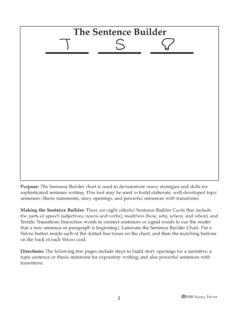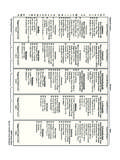Transcription of Expository Writing Lesson: 1-Sentence
1 300 2006 Nancy FetzerExpository Writing lesson : 1-SentenceOne Sentence: Primary LevelPurpose: This is the first organizer that primary-level writers (first grade-second grade) utilize towrite an Expository sentence that includes a setting, subject and big idea(topic sentence). The organ-izer displays the formula (setting, subject, big idea) and four boxes for planning ideas and recordingfancy words. The lines below the boxes are for students to write their powerful :Step 1: Plan: Students identify the subject of their sentence by asking: Who or what is the informationabout?
2 Students draw a picture or write their subject in the box below the heading, Subject . (See sediment in the example above.)Step 2: Plan: The big idea is the reason for Writing the information and why it is important. Reason or Purpose: The big idea is the reason for Writing the information. Although there arefour different categories for purpose (inform, explain, describe, or analyze), primary gradestudents should only use the first two: 1) to inform, or 2) to explain. Students identify the bigidea by asking: What about sediment? Am I going to inform my audience about different types of sediment;or explain how sediment changes things?
3 (Explain how sediment changes things.) Students draw a pic-ture in the box that shows their purpose, what information is being reported about of Information: The audience needs to understand why the information is importantto read. Once the reason or purpose of the Writing is identified, the student s then tell why or howthe information is important; or make a claim about the information; or show the effects or impactof the information. (Tell the effects of sediment. It changes landforms.)Step 3: Plan:Students identify the setting by asking: When is this happening and where?
4 Studentsdraw pictures in the boxes. (Please note: setting is only recorded if it makes sense.)Step 4: Talk: Students practice forming a sentence using the pictures for support: During bad weatherin the mountains, sediment goes down the hillsides causing 5: Plan: Students record fancy words in each of the boxes, then practice retelling their sen-tences including the fancy words: During stormy weather in the tall mountains, sediment flows, slides,and moves down the hillsides causing the landforms to 6: Talk and Write:When student are able to tell their sentences , they then write them down.
5 301 Who or Whatis the InformationAbout?Setting Subject Big Idea What about _____?Why is it important?When?Where?Secret Formula- Expository : Primary Level 2006 Nancy FetzerInform: Organize the details into groups or categories to or kinds 2006 Nancy FetzerExpository Paragraph: InformDefinition: To Inform: Categories for Details: The arrangement or grouping of informa-tion about living things, places, things or abstract ideas according to their similar attributes orcommon characteristics, thus main idea and supporting details; or the whole (main idea) toparts or types (supporting details).
6 Follow the listed steps for the Lesson: Step 1: Review of Information: To begin the Writing lesson , students need to review theirnotes, textbooks, etc. for all the information learned. Suggested steps to review informationlearned are listed. For this sample lesson , the topic was owls. After the review of information,a list was written on the board. Students used this list to figure-out the purpose of their para-graphs. Since a paragraph is one unifying idea, the list (which has two different purposesabout owls) needs to be narrowed to one. Students review their notes as follows: On Your Own (1-minute):Independently read notes about Share (1-minute):Share information.
7 Add any new information to Share (1-minute): Share information. Add any new information to Share (2-minutes):Students share information; Teacher records on is an example of notes the teacher recorded on the board during the Class Share .Teacher:Look at our list we developed. We have two purposes we could write about: 1) parts of an owlpellets, or 2) different body parts of an owl. (Body parts.) Look at the Inform box. There are manydifferent reasons we can inform our audience about owls. These reasons are the purpose for tellingabout the information.
8 (Different body parts of an owl.) 351 2006 Nancy FetzerAt the top of their blank papers(next page), students write the secret formula: S for setting, Sfor subject, and a light bulb for big idea. Students use the secret formula to form their topicsentences:Step 2: Topic Sentence: To form the topic sentence, students utilize the secret formula:S for setting, S for subject, and light bulb for big (S):Is a setting necessary for this information? When and where is this information occurring? (At night, in the forest.)Subject (S):Who/what is the subject of the information?
9 (Owls.)Big Idea: Purpose: What about owls? What is the reason/purpose for Writing about owls?(To tell about their different body parts.)Big Idea: Importance:Why is this information important? (These body parts are special so the owl can catch prey at night.)Please Note:In this sample lesson , the teacher used the Pattern Sentence Blueprint Cards(below) to make a more sophisticated sentence. For more detailed directions, see Chapter Paragraph: Inform352 2006 Nancy FetzerListed steps to write an Expository paragraph(continued):Step 3: Supporting Details: The detail sentences have a job to do.
10 Go back to the topic sen-tence. What was the purpose? That purpose will tell what details need to be in the paragraph,as well as how to finish drawing the : To Inform:What is my purpose? My purpose is to inform by organizing the detailsinto groups or categories to or kinds the similar details together into one of the categories. Determine how many categoriesare needed, then draw vertical lines in the middle of the organizer to make the number ofboxes match the number of details. In the example (above), the paragraph required four dif-ferent details, so three vertical lines were drawn to make four detail boxes ( , The four bodyparts an owl uses to catch prey).






